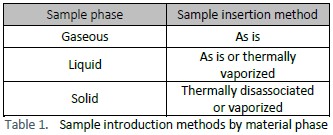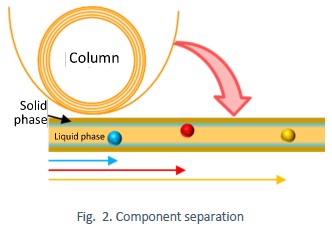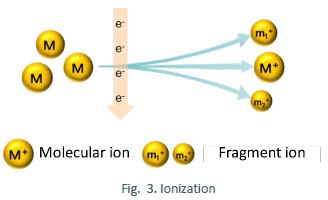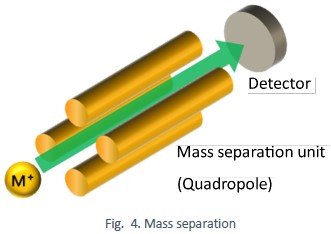GC/MS:Gas Chromatography Mass Spectrometry
Features
Gas chromatography (GC) separates components by using the differences in gas adsorption or partition coefficients for the solid phase. GC mass spectrometry (GC/MS) uses a mass spectrometer to identify and quantify the GC-separated components. GC/MS can be used for:
- Efficient analysis of components with relatively small molecular weight and high volatility
- Quantitative and quantitative determination of trace organic components
- Gas, liquid, and solid phase samples (see Table 1)
- Structural estimation of a wide range of organic compounds via an extensive library
Application Examples
- Structural analysis of polymers
- Analysis of degassing components during sample heating
- Evaluation of organic contamination on wafer surfaces
- Odour analysis
- Analysis of additives, impurities, and residual solvents in resins
- Working environment measurement
- Environmental pollutant analysis, especially volatile organic compounds (VOCs)
- Compositional analysis of gas in batteries
Principle
Sample introduction
|
Gaseous or easily vaporized liquids can be introduced directly into the GC apparatus. Solids are solubilized or vaporized by solvent extraction, thermal decomposition, or headspace methods and introduced into the GC equipment.
|

|
Component separation
|
The vaporized sample at the inlet is introduced to the column by a carrier gas. Due to the strong (polar) or weak (steric) interaction with the solid phase of the column, each component of the sample undergoes a migration of different magnitude, and the components are therefore mutually separated (Fig. 2).
|

|
Electron Ionization (EI)
|
The molecules of each component separated by GC are ionized by collision with thermal electrons emitted from a hot filament (Fig. 3). Some of these molecular ions are disassociated into fragments.
|

|
Mass separation
|
The ions and fragments are introduced into a quadrupole mass spectrometer (Fig. 4), which consists of four rods of different electric potentials. By adjusting the voltage applied to the rods, only ions of a specific mass reach the detector, yielding a mass spectrum with molecular mass information.
|

|
Data examples
Fig. 5 shows a total ion chromatogram (TIC) of the outgassed components during heating of an adhesive. The concentration of each component can be calculated from the peak area and calibration against a sample standard.
Fig. 6 and Fig. 7 show mass spectra corresponding to the substances of TIC peaks #1 and #2 in Fig. 5. By analysing their mass spectra, structure estimation of the component is possible.
Data delivery format
Portable Document Format (PDF) file.
Specifications
Items for enquiries
- Purpose and content of measurement
- Sample information
- Number of samples, and availability of preliminary samples
- Sample type (thin film, powder, solid, solution)
- Availability of destruction
- Handling instructions
- Details on delivery
- Preferred due date for preliminary analysis report
- Due date for delivery of final report
- Priority in the case of a large number of samples
- Any other issues
Caution
- GC/MS cannot detect volatile materials
- Substances that are not in the library can be difficult to estimate
- Standard samples are additionally required to verify and quantify the correct putative structure.
[GC/MS]ガスクロマトグラフィー質量分析法の分析事例はこちらからご覧ください。